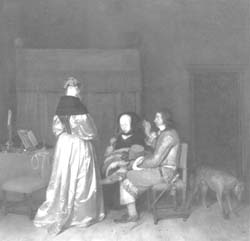|
News
|
|
|
Perspectives
|
|
|
Arts
|
|
|
Sports
|
|
|
Other
|
|

Allen Memorial Displays 17th Century Dutch Art
Exhibit Explores Hidden Symbols in Dutch Art
by Christina Morgan
The art of many famed 17th century Dutch masters is currently on display at the Allen Memorial Art Museum. The exhibition, entitled "Symbol and Meaning in Seventeenth-Century Dutch Art," opened at the Allen on June 20 and will run through Oct. 1. The artwork displays "a group of works that bring together the hidden meaning in Dutch art," according to Betsy Wieseman, curator of Western art before 1850 and the curator of the event.
The exhibition came to Oberlin through an exchange of artworks between Allen Memorial and the famed Rijksmuseum in Amsterdam. The Rijksmuseum houses the largest collection of Dutch and Flemish paintings in the world. Its most famous painting is Rembrandt's "The Night Watch", which, according to Spanish professor Sebastiaan Faber, a native of Holland, is equivalent "to seeing the ŚMona Lisa' in the Louvre."
The Rijksmuseum borrowed a piece of art from Allen Memorial's collection entitled "St. Sebastian Tended by Irene" by Hendrick Terbrugghen, for its showcase "The Glory of the Golden Age: Masterpieces of 17th Century Dutch Art." In return, the Rijksmuseum loaned two paintings, "The Paternal Admonition" by Gerard ter Borch and the "Portrait of Moses ter Borch" by Gerard and Gesina ter Borch for the current Allen exhibition.
The exhibition takes its title from the curator's desire to display the "prolific use of symbols and emblems in 17th-century Dutch genre painting and portraiture." For example, "The Paternal Admonition" has been interpreted by art historians in several different ways. Upon first glance, the painting appears to depict a simple scene of uncomplicated familial instruction. However, a closer look at the symbols and gestures included in the painting reveal more complex issues at hand such as a marriage proposal and even high-class prostitution.
The other painting on loan from the Rijksmuseum, "Portrait of Moses ter Borch," also lives up to the exhibition's claim that there is much symbol and meaning in 17th century Dutch art. The painting, a collaborative effort on the part of Moses' two half-siblings, includes many military, botanical and zoological symbols. These symbols were included in the portrait to express the heroism, fidelity and courage of Moses, who was killed in England during the Second Anglo-Dutch War.
The entire collection of works included in the exhibition are not only considered important by art historians because of their hidden layer of meaning, but also because they provide a view of many details of life in 17th century Netherlands. Many of the paintings on display, such as "Lady with Servant and Dog," "Lady with a Parrot," "Man with a Monkey" and "Sleeping Girl with Needlework in Her Lap," show scenes of every day life. At the same time, however, their many symbols and gestures convey a message of morality and earthly temptations.
A lecture was given this past Thursday by Dr. Alison M. Kettering of Carleton College entitled "Genre and Gender: the Art of Gerard and Gesina ter Borch." Kettering, an Oberlin College alumnus, is considered a noted ter Borch scholar. Works from the Carnegie Museum of Art in Pittsburgh and the Columbus Museum of Art also enrich "Symbol and Meaning in Seventeenth-Century Dutch Art."

"The Paternal Admonition": On display at Allen Memorial Art Museum. (photo courtesy Allen Memorial Art Museum)
Copyright © 2000, The Oberlin Review.
Volume 129, Number 2, September 22, 2000
Contact us with your comments and suggestions.